Increasingly, homeowners are opting to remain in their homes as they age—a concept known as aging in place. It’s a decision rooted in independence, familiarity, safety, and comfort. But living safely and comfortably in your home as your needs evolve isn’t automatic; it requires thoughtful planning and a few key home modifications to reduce risks and support daily life.
Before we dive into a room-by-room tour, let’s take a closer look at why making your home safer matters more than ever.
Why Home Modifications Matter for Aging in Place
A simple slip on a wet floor or a trip over a rug can change everything. According to the National Institute on Aging, more than one in four people age 65 or older falls each year. And for older adults, a broken bone can be more than a painful setback—it can lead to serious health problems and long-term disability.
But here’s the good news: many falls are preventable. Along with exercise, managing medications, and regular vision checks, making your house safer with home modifications plays a crucial role in reducing the risk of falls and injuries.
That’s why thoughtful changes—like widening doorways, installing grab bars, improving lighting, and smoothing flooring transitions—aren’t just conveniences. They’re essential steps to help older adults stay in their homes safely, comfortably, and independently for years to come.
In this article, we’ll take you room by room through an aging in place home, showing the practical modifications that make all the difference.
Making Your Home Entrance Safe and Accessible for Aging in Place
First things first: if you want to remain in your home as you age, you need to be able to safely get in and out. After all, what’s the point of maintaining your independence if you can’t come and go as you please?
At our aging in place home, the front entrance may still have a few steps, but they’re flanked by sturdy handrails on both sides for added stability. There’s even a grab bar at the landing for extra support while unlocking the door.
And you won’t be fumbling in the dark. Motion-sensitive lighting illuminates the entire walkway and entrance area, which is especially helpful for those with reduced vision. In some homes in Northern Virginia, garage entries are the preferred access point, offering fewer steps and easier maneuverability, especially when carrying groceries or using mobility aids, such as walkers or canes.
We also replaced the traditional doorknob with a lever-style handle, which is much easier to use for anyone with arthritis or limited grip strength. We installed a push-button lock to eliminate the need to fumble with keys. Smart locks and video doorbells, like Ring or SimpliSafe, add both safety and convenience—alerting homeowners with visual cues or phone notifications.
Inside, we removed common tripping hazards. The doormat is thin and slip-resistant, and any rugs are either secured with two-sided tape or removed entirely. That raised edge between the tile and hardwood? Gone. We’ve smoothed transitions throughout your home to make it easier to move with a walker or wheelchair.
Of course, stairs at the entrance—or between floors—can be a real challenge and cannot be avoided. In one of our recent projects in Great Falls, Virginia, we collaborated with a multigenerational family to design and build a thoughtfully designed home addition for the parents. It included a home elevator that connects a new private suite (main level) to the finished basement below, which has the same level rolling access to the garage) offering accessibility now and peace of mind for the future.
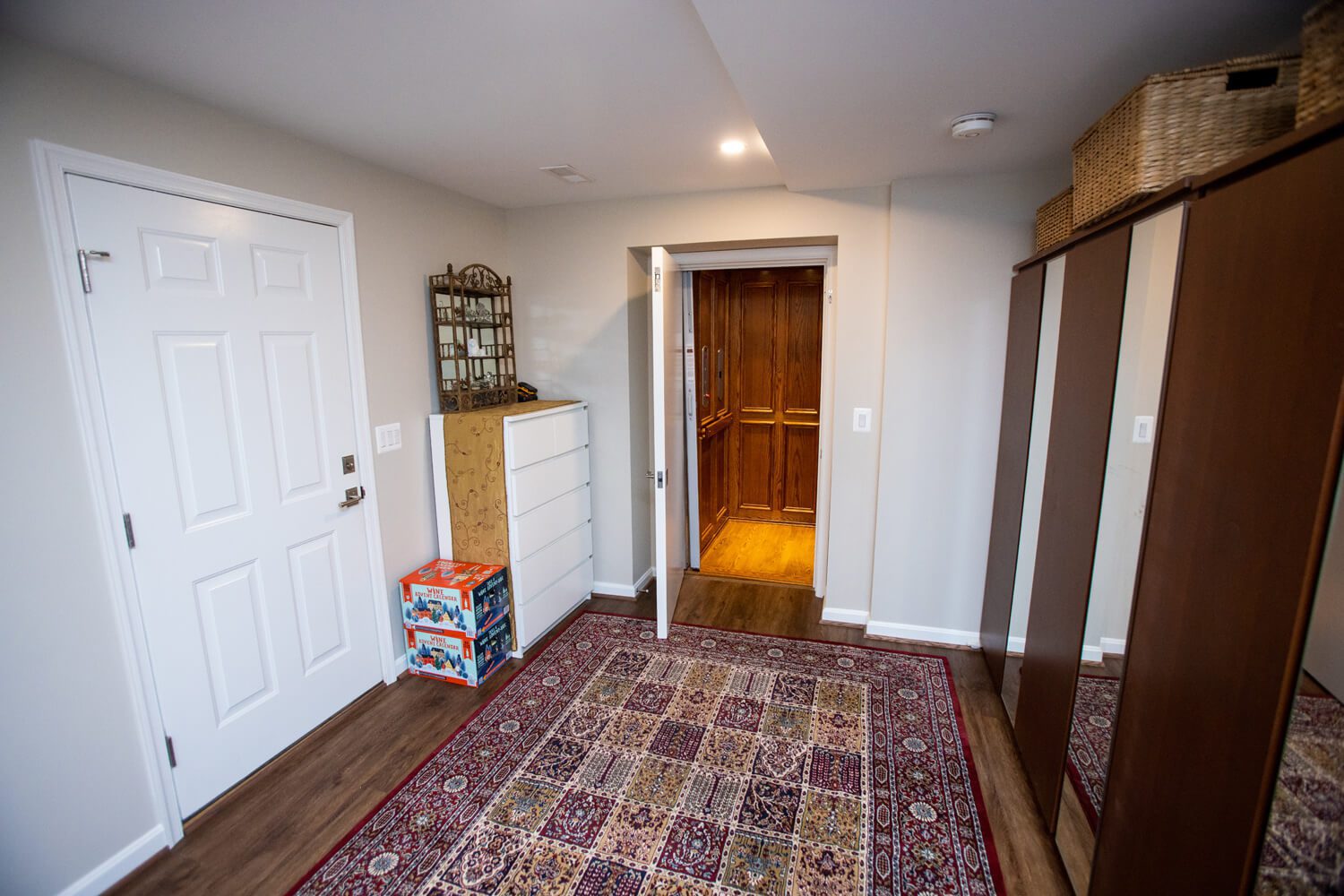
We know that not every home—or every homeowner—has the same needs. That’s why we focus on providing options: ramps where needed, elevators when appropriate, and always a layout that supports independence, safety, and maneuverability.
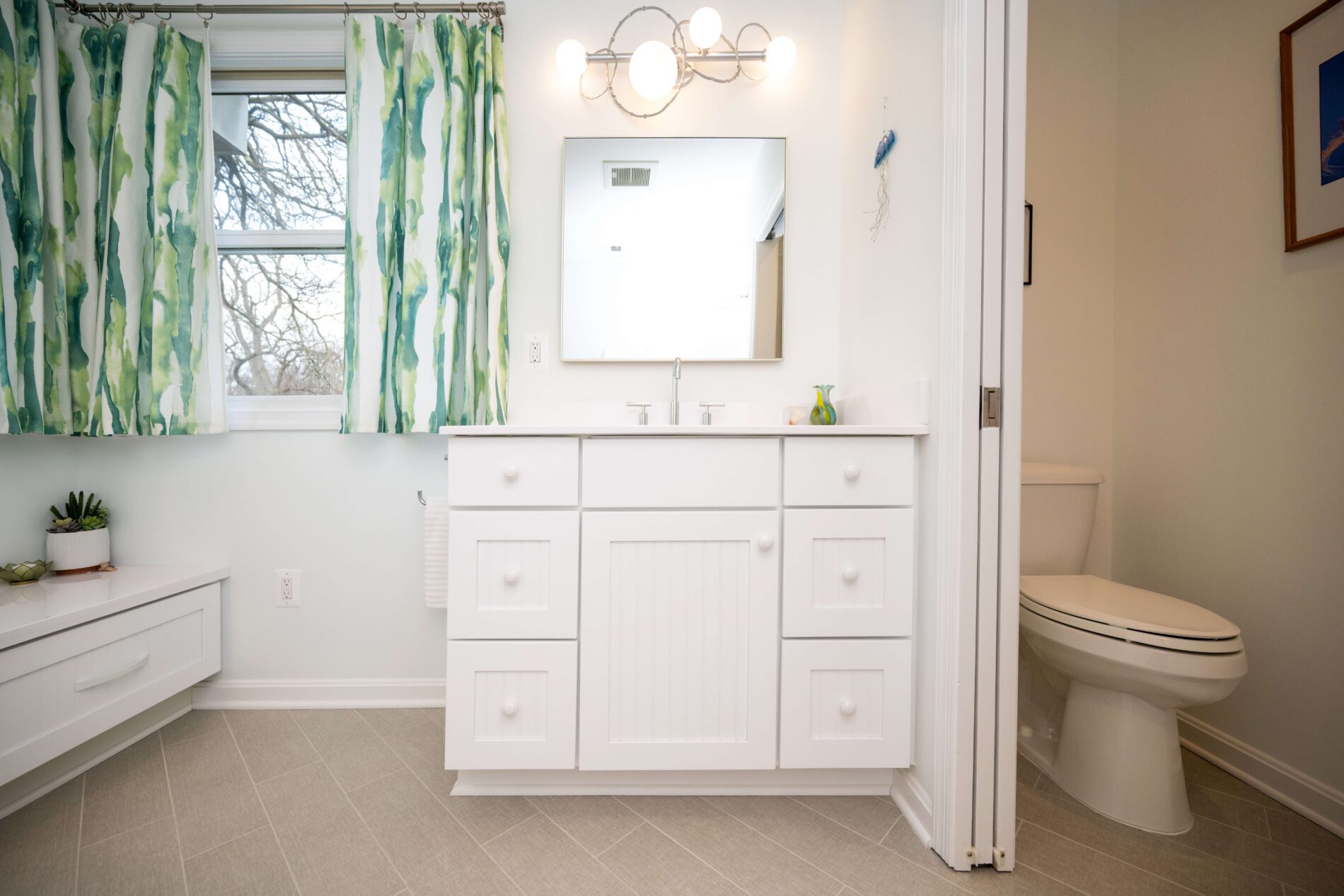
The Bathroom: Increase Safety and Accessibility
The bathroom can be one of the trickiest places in the home as we get older. It’s a space essential to both independence and modesty, but also one where slips and falls are most likely to happen.
As part of the bathroom design and renovation, we widened doorways to allow for easy entry, whether you’re using a wheelchair, a mobility aid, or simply want more room to move comfortably. Instead of a swing-in door, we chose a pocket door to save space and ensure emergency access if ever needed.
Here’s why that matters: If someone slips and falls inside a bathroom with an inward-swinging door—especially in a small powder room—it could be nearly impossible to open the door to help them. That’s why aging-in-place certified professionals strongly recommend outswing or pocket doors. It’s a small change that can make a big difference in an emergency.
We installed a comfort-height toilet with grab bars on either side to make standing up and sitting down easier. If you’re remodeling but not yet ready to add grab bars, we recommend installing blocking behind the wall so you’re prepared if support is needed later.
The high tub wall? Gone. A new zero-threshold walk-in shower lets you walk—or roll—right in. Inside, a fold-down teak bench provides a sturdy place to sit, and the handheld showerhead offers complete control without requiring awkward reaching.
But a seat isn’t just helpful in the shower. We’ve also added a fold-down bench outside the shower for putting on shoes or handling personal care.
We replaced slick tile with a patterned, textured version that’s easier for aging eyes to distinguish and helps reduce the risk of slips.
At night, motion-sensor lighting softly lights the way so you don’t have to fumble for a switch.
This bathroom isn’t just safer—it’s smartly designed to help you stay confident, comfortable, and in control.

The Bedroom: Creating a Comfortable and Supportive Sleep Space
Your bedroom has hopefully always been a place of rest, and that shouldn’t have to change as you age. With a few thoughtful home modifications, older adults can continue to sleep soundly and move safely.
We upgraded to a Sleep Number–style mattress that not only offers customizable firmness but also allows you to elevate your head or feet for comfort and circulation. Whether you’re reading, resting, or easing morning stiffness, a good bed can make all the difference.
To make getting in and out of bed easier, we often install grab bars that slip under the mattress. For additional support, a ratcheting floor-to-ceiling bar can be installed instead. These simple tools help you transition more safely between lying down, sitting up, and standing.
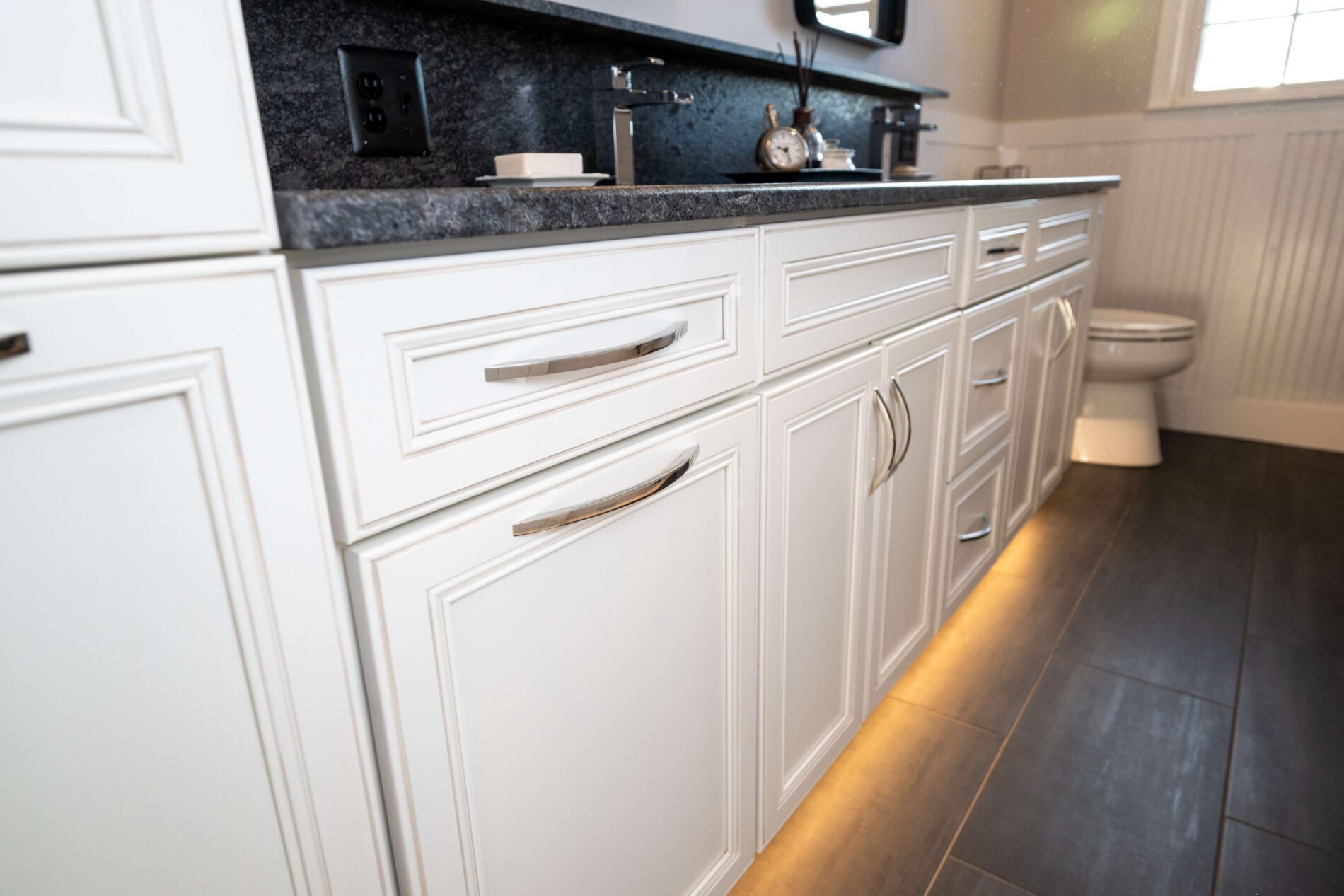
Nighttime lighting is crucial, especially for those who wake up frequently. Motion-sensor night lights gently guide the way to the bathroom or kitchen, while remote-controlled or voice-activated lights make everything more convenient.
Bedroom flooring is a personal choice. Some prefer hard surfaces because they reduce tripping hazards and make mobility aids easier to use. Others opt for carpet for its warmth and comfort. The best choice is the one that works best for your lifestyle and needs.
And in the closet? Open shelves or cubbies put daily clothing within easy eyesight and reach. A spring-loaded pull-down rod brings hanging clothes within easy reach—no stretching, no stepstools, no strain.
This bedroom isn’t just designed for sleep—it’s designed for how you live.
The Kitchen: Designing for Comfort, Access, and Daily Life
The main concern in accessible kitchen design is staying comfortable and safe while doing daily tasks—whether that’s cooking, cleaning, or grabbing a midnight snack.
To make movement easier, we replaced lower cabinets with drawer-style storage and added pull-out trays and retractable pull-down shelving in the upper cabinets. Lazy Susans in corner cabinets reduce the need for awkward twisting.
We swapped knobs for D-shaped cabinet pulls, which are more comfortable for those with arthritis. An air switch, located at the countertop level (not underneath the sink), makes the garbage disposal easier to use, while touch- or motion-activated faucets simplify tasks at the sink.
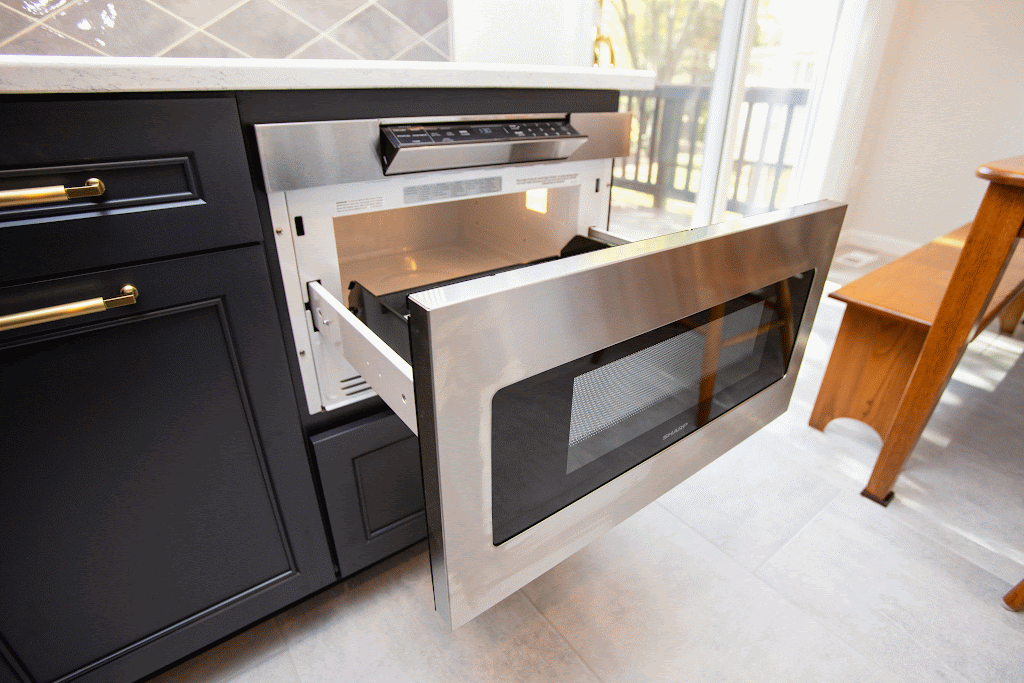
We also rethought the cooking appliances.
- Over-the-range microwaves can be challenging to access, so we opted for a microwave drawer instead.
- A French door oven opens from the middle, so you don’t have to lean over a hot door.
- An induction cooktop offers added safety by only heating the cookware, not the surrounding surface.
- And front-mounted range controls reduce the risk of burns.
Lighting matters, too. We added toe-kick lighting along the base of the cabinets and used dimmers to ease into the brightness. Motion sensors help make the space functional for both day and night.
And of course, every good kitchen has a clean-up assistant. In ours, it just happens to be the family dog—always ready to help with anything that hits the floor.
Throughout the Home: Small Changes That Make a Big Difference
Now that we’ve toured the main rooms, let’s examine a few less visible—but equally important—home modifications that help older adults stay safe and independent.
As you may recall, one of the first topics we addressed was flooring. Every transition—from hallway to kitchen, kitchen to bedroom—was smoothed out. We used non-slip materials with a slight texture and ensured that all thresholds were low or eliminated entirely.
We also widened the doorways—just a few inches, but enough to make a big difference. Whether you’re using a wheelchair, a mobility aid, or just want more space to move comfortably, wide, clear passageways improve both safety and flow.
Lever-style door handles replaced knobs throughout the home. They’re easier on the wrists, especially for those with arthritis, and allow seniors to open doors without grabbing or twisting. Paired with easy-touch light switches at reachable heights, they make the home feel more responsive to your needs.
Lighting plays a huge role in comfort and safety. We added motion-sensor lights in hallways, bathrooms, and closets, and installed dimmers so you can adjust overhead brightness based on the time of day.
In tighter spots—like powder rooms, laundry areas, and utility closets—we replaced traditional swing doors with pocket doors to create more maneuverable space.
And finally, we added a few smart home features to enhance peace of mind. From video doorbells and voice-controlled lighting to remote-controlled exhaust fans with timers, these tools don’t just make life easier—they make the home feel more connected and secure.
Sometimes, it’s not the dramatic remodels but these smaller, thoughtful changes that have the most significant impact.
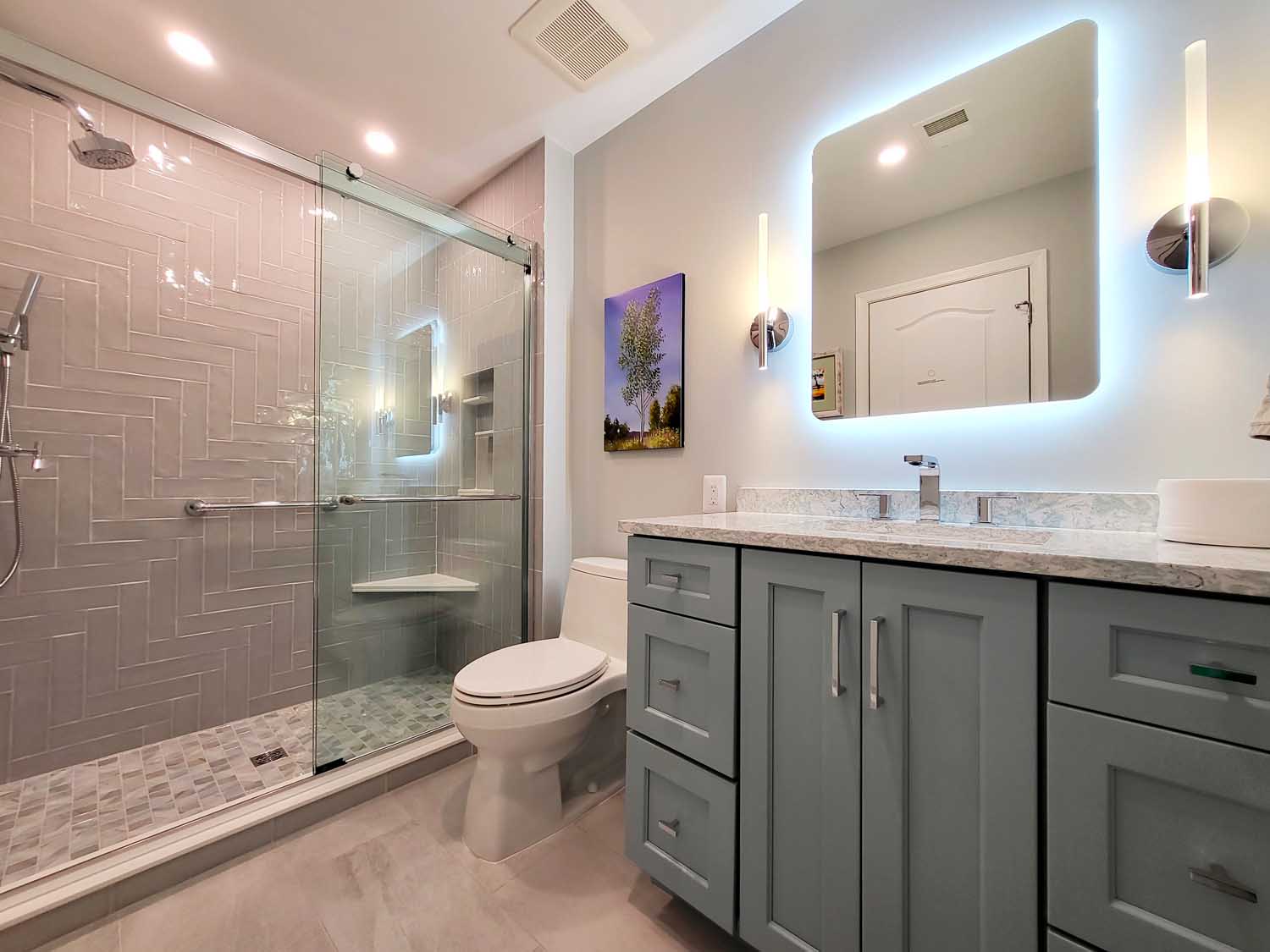
Aging in Place vs. Assisted Living: A Look at the Bigger Picture
For many older adults, the decision to undertake an aging in place remodel isn’t just about comfort—it’s about staying in the home they love, in the community they know, surrounded by neighbors and memories. But it’s also a financial decision worth considering.
Assisted living can come with a significant price tag. Some facilities charge hefty upfront fees—sometimes hundreds of thousands of dollars—plus monthly costs that range from $4,000 to over $10,000. For higher levels of care, we’ve seen costs climb to $20,000 a month or more.
Compare that to home modifications. Yes, there’s an investment involved—but it’s a one-time cost that typically pays for itself within months (when compared to assisted living).
More importantly, an aging in place renovation gives you the ability to remain where you’re most comfortable—where the light hits the floor just right in the afternoon. Where your neighbors still wave from the sidewalk. Where the creak in the stairs is familiar—and somehow comforting.
Aging in place isn’t about ignoring future needs. It’s about planning for them now, on your terms. Maybe that means reconfiguring the layout so everything you need is on the first floor. Maybe it’s better lighting, or smoother flooring, or a home elevator. Whatever it looks like for you, the goal is the same: a home that supports how you want to live—not just where.
And that’s not something you can put a price tag on.
Ready to get started? We’re finalizing a helpful room-by-room checklist that will guide you through these modifications. In the meantime, feel free to reach out with questions or to start a conversation about what’s possible in your home.
